Nuns and Pilgrims
Tordesillas and Santiago de Compostela, May 23 and 24
Leaving Salamanca, we detoured slightly to visit Tordesillas, where the eponymous treaty was signed in 1694 dividing the world for colonization between Spain and Portugal. Juana la Loca, the mother of Charles V, was sequestered here, supposedly to spare her son embarrassment, and it is still the site of a royal convent, founded by Peter the Cruel in the 14th Century to stash his mistress, a noblewoman from Seville. To keep the mistress happy in austere Castille, he built the convent with many Moorish features reminiscent of Sevillian architecture. It is maintained in beautiful condition today, thanks to successive generations of nuns from the order of Santa Clara. Eleven cloistered nuns still live in the convent and help support themselves by selling sweets to the public—but only via a turntable that permits product and payment to be exchanged without face-to-face contact between the nun and the buyer.
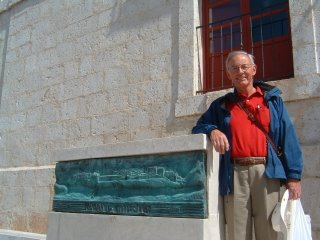
Tordesillas treaty plaque
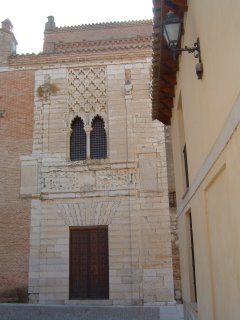
Real Convento de Santa Clara

Nuns' cloister at Santa Clara
We arrived in Santiago de Compostela at the beginning of the Fiesta de la Ascension and were treated to street dancers in fantastic masks and a peculiar display of rockets that exploded overhead with bangs and puffs of smoke—daytime fireworks, you might say. The city is always in a fiesta mode, the guidebooks report, for the steady stream of pilgrims, pumped up by the conclusion of their long journey, are in a mood to celebrate. One street leading to the cathedral is lined with tapas bars, where we ate pimientos de padrón, extraordinarily tasty tiny green peppers flash-fried in olive oil.
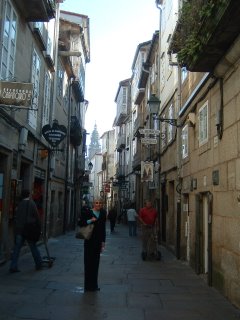
Santiago street scene
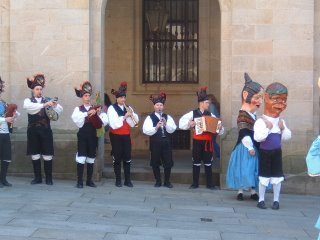
Street dancers and band (Santiago)
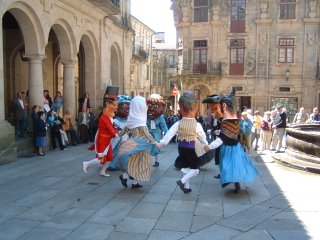
Street dancers (Santiago)
The Cathedral of Santiago was built to house what are supposedly the remains of St. James the Apostle, who had a posthumous career leading the Spanish Christian forces in battles against the Moors. Although impressive additions were made in later centuries, the heart of the cathedral is the 12th Century Portico de la Gloria (see below), which portrays James sitting below Christ and welcoming pilgrims at the end of their journey.
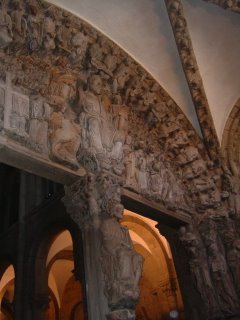
Portico de la Gloria (Santiago cathedral)

Cathedral towers (Santiago)

Hostel (now Parador) de los Reyes Catolicos (Santiago)
We opted for lodging outside the city with easy parking for Valeriu and found a little inn in a 250-year old building eight miles to the west. It was charming and reasonably priced with good food, including baked ray, a first for us. However, the place was vaguely reminiscent of Fawlty Towers with loud orders from the chatelaine, uncertain if well intentioned waiters (remember Manuel?), and repair projects underway during the 9:00 p.m. dinner hour.
We drove a few kilometers further to the west to see one of the Atlantic inlets for which Galicia is famous. As the picture below suggests, this is a beautiful area, but we were surprised by how few pleasure boats we saw—only one sailboat on the water and just a few in marinas. On the hill behind the inlet you may be able to make out some power-generating windmills, which we have seen in all parts of Spain that have a good breeze. (In contrast, we also offer a picture of traditional windmills, these near Valencia, that seem to be fast disappearing from the landscape.) On our drive we were intrigued by the hórreos, small, almost chapel-like structures, typically topped by a cross and raised on stilts, in which Galician farmers store their grain.
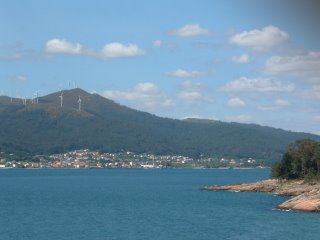
Galician coast
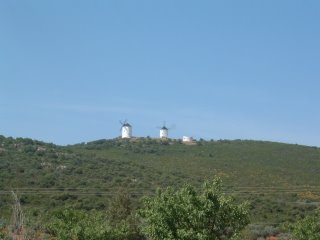
Old style windmills
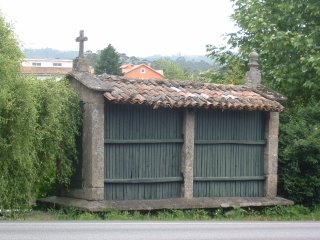
Hórreo

0 Comments:
Post a Comment
<< Home